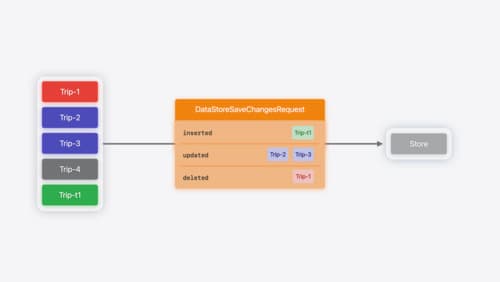How can I use the managedObjectContext property of an NSManagedObject?
Asked on 2024-07-30
1 search
To use the managedObjectContext property of an NSManagedObject, you can follow the principles outlined in the sessions from WWDC 2024. Here are some key points:
-
Model Context: The model context reads and writes data using a store in a model container. It tracks changes to your models and saves them to the store when needed. For example, if you make changes to your data, such as adding or deleting items, these changes are tracked by the model context and saved to the store (Create a custom data store with SwiftData).
-
History Tracking: SwiftData provides a history API that allows you to track changes over time. This can be useful for features like syncing changes with a remote server or reflecting changes in different parts of your app, such as a widget extension (Track model changes with SwiftData history).
-
Custom Data Stores: You can create custom data stores that use their own implementation to persist data. This allows you to use SwiftData APIs with any storage format or persistence backend (Create a custom data store with SwiftData).
-
Transactions and Changes: SwiftData history is composed of transactions and changes. Each transaction groups together all changes that occurred in the data store, and each change represents a model that has been inserted, updated, or deleted (Track model changes with SwiftData history).
For more detailed information, you can refer to the following sessions:
- Create a custom data store with SwiftData
- Track model changes with SwiftData history
- What’s new in SwiftData
These sessions provide comprehensive insights into managing data with SwiftData, including the use of model contexts and custom data stores.

Create a custom data store with SwiftData
Combine the power of SwiftData’s expressive, declarative modeling API with your own persistence backend. Learn how to build a custom data store and explore how to progressively add persistence features in your app. To get the most out of this session, watch “Meet SwiftData” and “Model your schema with SwiftData” from WWDC23.

What’s new in SwiftData
SwiftData makes it easy to add persistence to your app with its expressive, declarative API. Learn about refinements to SwiftData, including compound uniqueness constraints, faster queries with #Index, queries in Xcode previews, and rich predicate expressions. Join us to explore how you can use all of these features to express richer models and improve performance in your app. To discover how to build a custom data store or use the history API in SwiftData, watch “Create a custom data store with SwiftData” and “Track model changes with SwiftData history”.

Platforms State of the Union
Discover the newest advancements on Apple platforms.
